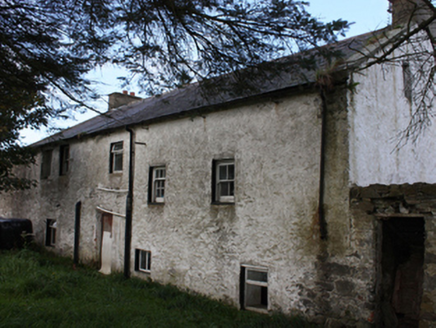Survey Data
Reg No
40802005
Rating
Regional
Categories of Special Interest
Architectural, Social, Technical
Original Use
Mill (water)
Historical Use
Mill (water)
In Use As
House
Date
1780 - 1800
Coordinates
252970, 448887
Date Recorded
14/10/2008
Date Updated
--/--/--
Description
Detached three-bay two-storey former miller’s house, built c. 1780, having remains of ruinous roofless two-storey former corn mill and later as a corn\flax threshing mill with waterwheel, adjoining to the west. Pitched natural slate roof with smooth rendered chimneystacks and raised rendered verges to the gable ends (east and west), projecting eaves course, and with surviving sections of cast-iron rainwater-goods. Roughcast rendered and whitewashed random rubble stone walls. Square-headed window openings with stone sills and with eight-over-eight and three-over-three pane horned timber sliding sash windows to first floor level, and eight-over-eight and four-over-four pane timber sliding sash windows to ground floor level; assortment of timber sash and casement windows to rear. Square-headed door openings with replacement battened timber doors with plain overlights. Attached six-bay two-storey former mill building to west, now roofless, having whitewashed random rubble walls, and square-headed window and door openings having random rubble stones relieving arches over timber lintels. Two single-bay single-storey gabled projections to the north elevation of former mill having pitched natural slate (east) and pitched corrugated-metal (west) roofs, rubble stone walls, and square-headed openings. Metal breasts hot waterwheel to the west elevation of mill formerly with timber paddles, now gone. Waterwheel set in rubble stone wheel pit with round-headed arched opening to the south allowing headrace in. Former mill pond to the south, now silted up. Remains of head race to the south and tailrace to the north (flowing in and out of the Culdaff River to the west). Located at end of long approach avenue from the north-east. Located to the south of the centre of Culdaff and adjacent to the east of the Culdaff River. Possible remains of ancillary building to the south-east (not investigated).
Appraisal
This interesting complex, consisting of a former miller’s house(s) and an adjoining former corn mill and threshing mill, is an integral element of the built heritage of the Culdaff area. The mill is now sadly a roofless ruin but the former miller’s house survives in relatively good condition retaining much of its early character and form. Its integrity is enhanced by the retention of much of its salient fabric including natural slate roof and timber sliding sash windows, while the irregular spacing of the openings and the whitewashed rubble stone construction lends it a pleasing vernacular character. The attached former mill, although now ruinous, is an interesting example of its type and date. It was in use as a corn mill during the early-nineteenth century (Ordnance Survey first edition six-inch map) and was extended with the addition of a corn kiln (possibly the small structure to the south-west of the site, not investigated) by c. 1860 (Griffith’s Valuation map). It is indicated on the Ordnance Survey twenty-five inch map sheet of 1900-2 as a threshing mill. This mill would have provided a basic service to local farmers in grinding, threshing and milling and their corn and\oats. Of particular interest and importance is the survival of the iron breast shot waterwheel the west end of the building, which provides an interesting insight in historical industrial methods. This waterwheel was powered using water stored in a mill pond adjacent to the south, which itself was filled with water diverted from the Culdaff River along a headrace from the south and east. The tail race then discharged water back into the river to the north-west. The mill probably originally dates to the late-eighteenth or the early-nineteenth century, a period that saw a great boom in the Irish corn milling industry. The modest scale of this complex indicates that it was a vernacular corn mill, rather than a large-scale merchant corn mill as found more commonly in other parts of Ireland, notably the midlands, south-east and south of the country. This mill was probably in the ownership of either a Richard Anderson or an Alexander Henderson in 1881 (Slater’s Directory). This former miller’s house is an integral element of the built heritage of Culdaff, while the mill is an addition to the industrial archaeology of Donegal.













